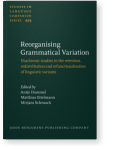Ablaut reorganisation
The case of German x-o-o
The present paper argues for the existence of an 8th Ablaut Class in German which, comparable to the analogical emergence of Class VII in West-Germanic, evolved analogically in the course of ablaut reorganisation processes in Early New High German. Class VIII is characterised by the pattern x-o-o with a uniform exponent o in the past tense and present perfect as opposed to a relatively variable vowel in the infinitive stem (e.g. melken ‘to milk’, klimmen ‘to climb’, schwören ‘to swear’). The analogical extension of the pattern x-o-o (originally stemming from Class II) is highly functional in that it presents a partial regularisation strategy for low-frequency strong verbs (e.g. melken – malk – gemolken → molk – gemolken).
Article outline
- 1.The rise of a new series: The 8th Ablaut Class
- 2.Class VIII as the result of a regularisation process
- 2.1The pattern x-o-o as a partial regularisation strategy
- 2.2Frequency-driven regularisations
- 3.Becoming a member of Class VIII
- 3.1Determinants of ablaut pattern extension: The case of x-o-o
- 3.2Restrictions for class membership
- 4.Ablaut (re)functionalisation
- 5.Conclusion: “Ablaut system under reconstruction”
-
Acknowledgements
-
Notes
-
References
